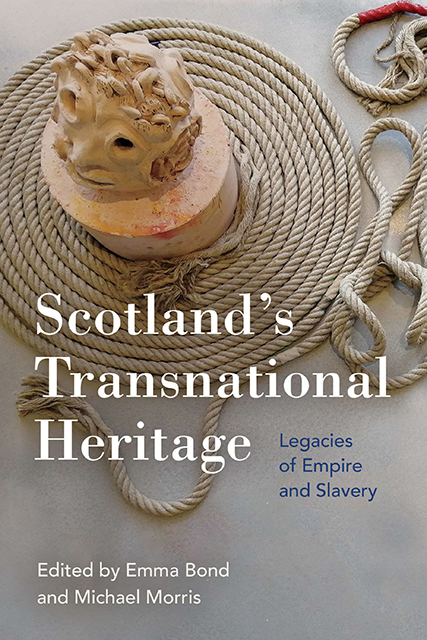Book contents
- Frontmatter
- Contents
- List of Figures
- Notes on Contributors
- Acknowledgements
- Foreword: Fostering Recognition under the Luxury of Amnesia
- Chapter 1 An Introduction to Scotland’s Transnational Heritage: Sites, Things and Time(s)
- Part I Transnational Sites
- Part II Transnational Things
- Part III Transnational Time(s)
- Afterword: Building Solidarity: Moving Towards the Repatriation of the House of Ni’isjoohl Totem Pole
- Index
Chapter 13 - Avowing Slavery in the Visual Arts
Published online by Cambridge University Press: 25 October 2023
- Frontmatter
- Contents
- List of Figures
- Notes on Contributors
- Acknowledgements
- Foreword: Fostering Recognition under the Luxury of Amnesia
- Chapter 1 An Introduction to Scotland’s Transnational Heritage: Sites, Things and Time(s)
- Part I Transnational Sites
- Part II Transnational Things
- Part III Transnational Time(s)
- Afterword: Building Solidarity: Moving Towards the Repatriation of the House of Ni’isjoohl Totem Pole
- Index
Summary
Introduction
The coppersmith William Forbes seized the opportunities offered by Britain’s growing involvement in the Atlantic trading system. Sugar production on the slave plantations of the Caribbean required large copper boiling pans, which were used to reduce the cane juice into sugar crystals and molasses. Forbes became expert at the production of the highest quality pans at the most competitive prices, attaining a near monopoly on their supply. Such was the extent of his business that he later became the main supplier of copper to the Royal Navy, for sheathing ships to protect their hulls during patrols in tropical waters. By the time Forbes retired, he was so wealthy that he was able to pay for his country estate, Callendar, with a single, specially printed £100,000 banknote.
Scottish National Portrait GalleryIn 2018, the Scottish National Portrait Gallery opened an exhibition titled The Remaking of Scotland: Nation, Migration, Globalisation 1760–1860, in which hangs Henry Raeburn’s 1798 portrait of Aberdeen-born Sir William Forbes of Callendar (1743–1815). Originally intended to hang 5 feet off the floor and to be viewed from a distance of 22 feet, this imposing full-length portrait ‘forcefully conveys Forbes’ ambitious self-regard’. Displaying Raeburn’s dramatic use of lighting, a rope-cord ties back a plush red curtain to reveal a rolling pastoral landscape, and illuminate Forbes perusing papers on a table, which may politely hint at the commercial source of wealth of the new occupant of the fourteenth-century mansion. The new exhibition notes that ‘the transformation’ of the period ‘came at great cost. The new imperial economy was built on slavery and warfare, while industrialisation … ravaged the natural envi-ronment.’ Indeed, Nuala Zahedieh argues that Forbes’ success was a ‘global story which puts flesh on Eric Williams’s thesis’ that British industrial capitalism was nurtured by Atlantic slavery. In the 1770s, Forbes first profited from the Caribbean slave-sugar industry by developing intimate links with a number of West Indian plantation owners, and later East India Company officials. West Indian plantation owners, and later East India Company officials.
- Type
- Chapter
- Information
- Scotland's Transnational HeritageLegacies of Empire and Slavery, pp. 200 - 217Publisher: Edinburgh University PressPrint publication year: 2023



